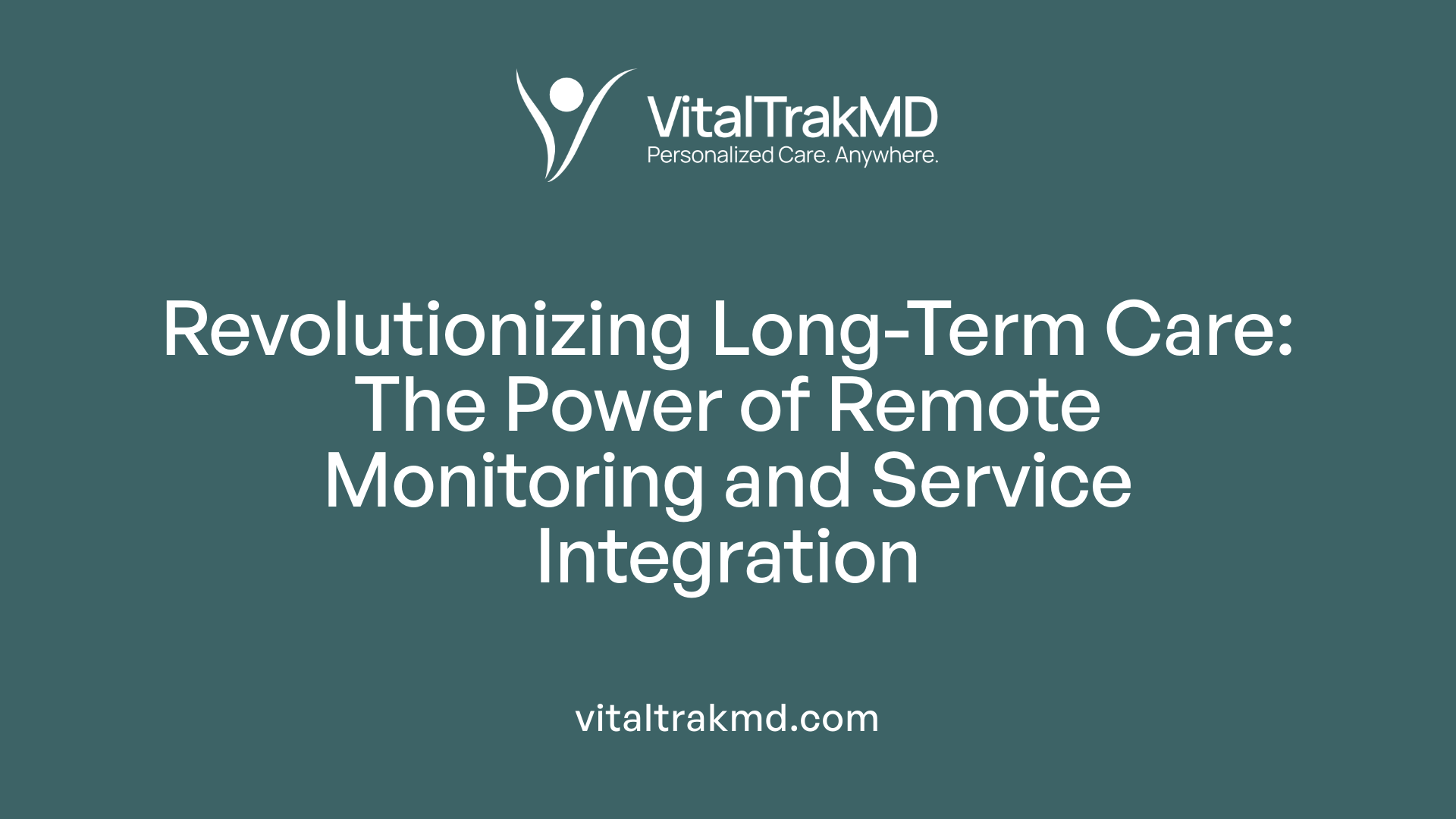The Role of Hybrid Care in Monitoring Long-Term Health Improvements

Transforming the Future of Healthcare Delivery
Hybrid care, integrating traditional in-person services with cutting-edge digital health solutions, is revolutionizing the management of long-term health conditions. This comprehensive approach enhances patient engagement, improves clinical outcomes, and addresses systemic healthcare challenges such as staff shortages and accessibility issues. Drawing from recent technological advances and innovative healthcare models like those developed at the Sheba Medical Center, this article explores the multifaceted role of hybrid care in monitoring and promoting sustained health improvements across various settings.
Utilization of Hybrid Care Across Healthcare Settings

In what healthcare settings can hybrid care be applied for effective long-term health monitoring?
Hybrid care is transforming healthcare delivery by blending traditional in-person services with digital health technologies. This approach is highly versatile and can be effectively implemented across a variety of healthcare environments to support continuous, personalized care.
One of the primary settings for hybrid care is primary healthcare clinics, where it facilitates regular check-ups, preventive screenings, and chronic disease management. Patients can have physical visits supplemented with remote consultations, use wearable devices for ongoing vital sign monitoring, or participate in digital therapeutics.
Chronic disease management benefits significantly from hybrid models. For example, managing diabetes or cardiovascular conditions involves routine monitoring with remote sensors and virtual visits for adjusting treatment plans. The Sheba Medical Center in Israel exemplifies this approach with its hybrid model that combines hospital care, remote patient monitoring, and home hospitalization for stable patients with complex multi-morbidity.
Mental health services have also incorporated hybrid care, leveraging digital platforms to offer virtual therapy sessions, digital support tools, and remote crisis intervention, which has improved access and patient satisfaction.
Rehabilitative care, including physical therapy and post-surgical recovery, uses hybrid strategies to tailor therapy programs, monitor progress via apps and wearables, and reduce the need for frequent hospital visits. Remote monitoring and virtual check-ins foster better adherence and early intervention.
Emergency response and acute care settings are increasingly adopting hybrid models for triage, remote consultation, and post-discharge follow-up. This approach helps manage patient flow, ensures timely care, and reduces hospital overcrowding.
Hybrid models are also invaluable in rural and underserved areas where infrastructure limitations, workforce shortages, and geographical barriers hinder access to specialized care. Telehealth bridges these gaps, enabling local clinics to connect seamlessly with specialists and hospitals.
Overall, the versatility of hybrid care allows healthcare providers to extend high-quality, efficient, and patient-centered services across diverse settings, promoting better health outcomes, improved access, and greater system resilience.
| Healthcare Setting | Typical Applications | Technologies Involved | Benefits |
|---|---|---|---|
| Primary Care | Routine check-ups, preventive care | Teleconsultations, remote monitoring devices, apps | Increased access, early diagnosis, better adherence |
| Chronic Disease Management | Long-term monitoring, treatment adjustments | Wearables, digital therapeutics, telehealth platforms | Improved outcomes, cost savings, patient engagement |
| Mental Health Services | Counseling, therapy sessions, crisis support | Video conferencing, mental health apps, digital tools | Enhanced accessibility, reduced stigma, higher satisfaction |
| Rehabilitative Care | Post-surgical rehab, physical therapy | Virtual coaching, remote sensors, mobile health apps | Personalized therapy, reduced hospital visits, adherence |
| Emergency and Acute Care | Triage, remote specialist consultation, follow-up | Virtual triage systems, remote diagnostics, data platforms | Faster response, better resource allocation, reduced overcrowding |
These settings demonstrate the flexibility and potential of hybrid care to revolutionize health management, especially as digital tools become more sophisticated and integrated into routine practice.
Enhancing Ongoing Management and Recovery with Hybrid Models

How do hybrid healthcare models contribute to ongoing health management and recovery?
Hybrid healthcare models play a crucial role in supporting continuous care pathways by blending traditional in-person services with innovative digital solutions such as remote monitoring, telehealth consultations, and virtual check-ins. This approach creates a flexible and personalized care environment that adapts to each patient’s unique needs.
During crises like the COVID-19 pandemic, these models proved vital in managing patients outside of hospital settings, reducing bed occupancy and limiting exposure risks. They enabled effective monitoring and assessment of patients in real-time, supporting recovery without overwhelming healthcare facilities.
Remote diagnostics and assessments—using devices like vital signs sensors, ECG monitors, portable x-ray systems, and telehealth platforms—allow for ongoing health evaluations. These tools provide timely data, facilitating early detection of complications and enabling adjustments to treatment plans promptly.
Patient engagement and adherence tend to increase with hybrid models. Digital communication fosters stronger relationships between patients and providers, offering more frequent touchpoints and reassurance. Patients are more likely to follow treatment recommendations when they feel supported through continuous virtual contact.
Furthermore, hybrid care optimizes healthcare resources by reducing unnecessary hospital visits and enabling more efficient use of clinical staff and facilities. It allows for earlier diagnosis, less travel for patients—including those in rural or underserved areas—and streamlined coordination across multidisciplinary teams.
Challenges such as integrating various digital platforms and addressing digital literacy or connectivity gaps remain. However, ongoing advancements in AI, data management, and secure communication are paving the way for more scalable and inclusive hybrid care solutions.
Overall, hybrid healthcare models are transforming recovery and long-term disease management. They foster patient-centered, resilient systems that improve health outcomes, enhance safety, and are adaptable in face of future health crises.
Monitoring and Improving Long-Term Outcomes via Hybrid Care
What is the role of hybrid care in monitoring and improving long-term health outcomes?
Hybrid care combines in-person visits with remote healthcare services, creating a flexible and continuous approach to managing chronic diseases and enhancing patient well-being. This model is particularly effective for long-term health monitoring, as it allows healthcare providers to maintain regular contact with patients through virtual check-ins, remote monitoring devices, and digital health interventions.
By integrating technology such as wearable sensors, smartphone apps, and data management platforms, hybrid care enables real-time tracking of vital signs, symptoms, and treatment adherence. This constant flow of information facilitates early detection of health issues before they escalate, allowing for prompt intervention.
Moreover, hybrid models foster stronger patient engagement. Patients are more likely to adhere to their medication schedules, lifestyle modifications, and monitoring routines when they receive regular virtual support and personalized feedback. This active participation improves disease control, particularly in chronic conditions like diabetes, cardiovascular diseases, and autoimmune disorders.
Access to care is significantly expanded through hybrid models, especially for patients living in remote or underserved areas. It reduces common barriers such as travel time, transportation costs, and limited local healthcare resources. As a result, patients experience fewer hospital readmissions and emergency visits, which lowers overall healthcare costs.
Hybrid care also supports better care transitions, ensuring that patients move smoothly from hospital to home or between different care settings. This continuity of care is vital for maintaining health stability and preventing complications.
In summary, hybrid care enhances the monitoring of long-term health outcomes by offering personalized, accessible, and proactive management. Its ability to combine virtual and physical services leads to early detection of problems, improved patient adherence, fewer hospitalizations, and ultimately, better health resilience over time.
Hybrid Care's Influence on Mental Health Outcomes

How does hybrid care impact mental health and contribute to long-term mental health outcomes?
Hybrid care plays a vital role in transforming mental health treatment by blending traditional in-person therapy with innovative digital tools. This approach combines synchronous sessions, such as telehealth or face-to-face meetings, with asynchronous digital resources that patients can access anytime. These resources include symptom-monitoring apps, virtual reality experiences, chatbots for support, and passive data collection through wearable devices.
By integrating these tools, hybrid care enables continuous monitoring and personalized intervention, allowing clinicians to tailor treatment plans more effectively. Digital tools also facilitate early detection of mental health issues, thereby enabling timely support before crises escalate.
Support roles like digital navigators and mental health clinicians are essential in helping patients maximize engagement with digital resources. They assist in navigating technology, provide encouragement, and ensure that digital interventions complement traditional therapy.
The positive impact of hybrid models is evident in several clinical settings. For example, Beth Israel Deaconess Medical Center’s Torus Clinic has successfully employed hybrid care to treat depression and anxiety. Their approach has demonstrated significant reductions in symptom severity, while also improving access, adherence, and patient satisfaction.
Overall, hybrid mental health care fosters a flexible, patient-centered environment that enhances long-term outcomes. By combining human support with digital innovation, it supports sustained mental health improvements, making care more accessible, personalized, and effective.
Impact of Remote Monitoring and Service Integration on Long-Term Health

What impact does hybrid care have on long-term health improvements through remote monitoring and integrated services?
Hybrid care models, which combine remote monitoring technologies with in-person healthcare services, are transforming the management of chronic diseases and long-term health conditions. These approaches enable continuous health oversight, allowing healthcare providers to detect early signs of deterioration, adjust treatments promptly, and prevent complications.
One of the primary advantages of hybrid care is its ability to improve patient engagement and adherence. Digital tools such as wearable sensors, smartphone apps, and remote check-ins foster a proactive attitude toward health management. Patients become active participants in their care, which is crucial for conditions like diabetes, cardiovascular diseases, and respiratory illnesses.
Early intervention is significantly enhanced by remote monitoring, reducing the need for emergency visits and hospitalizations. For example, continuous glucose monitoring for diabetics provides real-time data, allowing timely adjustments that stabilize blood sugar levels. Similarly, vital signs sensors and remote diagnostics enable swift responses to abnormal readings, often before symptoms worsen.
Data-driven decision-making is at the core of hybrid models. Large amounts of health data collected remotely help clinicians identify patterns and predict potential health issues. This insight supports personalized treatment plans, tailored to each patient's unique health profile, increasing the likelihood of successful long-term management.
Incorporating personalized interventions—such as medication adjustments, lifestyle recommendations, and remote therapy sessions—through digital platforms ensures ongoing support outside traditional clinical environments. This continuous care model encourages better adherence, healthier behaviors, and sustained treatment outcomes.
Furthermore, hybrid care addresses health equity by expanding access to specialized and routine care for remote and underserved populations. Virtual consultations and home-based monitoring reduce disparities caused by geographic, transportation, or resource barriers, promoting more equitable health outcomes.
Numerous studies have demonstrated that integrating remote monitoring with traditional healthcare delivery can lead to improvements comparable to, or better than, conventional care. For chronic conditions, evidence points to reduced hospital readmission rates, improved clinical metrics such as HbA1c levels, and higher patient satisfaction.
The fusion of supportive policies, advanced technologies, and flexible service delivery models results in a resilient healthcare system capable of maintaining and enhancing long-term health. By ensuring continuous monitoring, personalized care, and expanded access, hybrid models foster durable health improvements that are both effective and sustainable.
| Aspect | Benefits | Supporting Evidence |
|---|---|---|
| Continuous Monitoring | Enables early detection and intervention | Studies on remote glucose and vital sign monitoring |
| Data-Driven Decisions | Allows personalized treatment adjustments | Improved clinical outcomes and predictive analytics |
| Personalized Plans | Tailored interventions improve adherence | Patient-centric models showing lasting health benefits |
| Access and Equity | Reaches remote populations, reducing disparities | Demonstrated success among underserved communities |
| Overall Outcomes | Reduced hospitalizations, better health metrics | Long-term studies on chronic disease management |
Hybrid care’s integration of telehealth innovation with traditional services marks a significant step toward sustainable, patient-centered health management, promising long-lasting health benefits across diverse populations.
Technological and Design Strategies in Hybrid Care Models
What are the technological components and design strategies essential for developing effective hybrid care models for sustained health monitoring?
Building a successful hybrid care model relies on a diverse array of technological tools carefully integrated into patient care workflows. By leveraging advanced hardware and software, healthcare providers can support continuous monitoring, improve patient engagement, and enhance clinical decision-making.
Key technological components include wearable sensors that track vital signs and activity levels, remote examination devices like TytoCare kits that enable virtual auscultation and physical assessment, and telehealth platforms that facilitate real-time video and audio interactions. These tools should be compatible with integrated electronic health records (EHRs) to ensure seamless data sharing among providers.
Artificial intelligence (AI) and predictive analytics play vital roles by analyzing large volumes of health data to detect patterns, predict health deterioration, and personalize treatment plans. These technological integrations support proactive care and early interventions.
Design strategies must emphasize user-centered interfaces that are intuitive for both providers and patients, reducing barriers to technology adoption. Interoperability is crucial, allowing diverse devices and systems to communicate smoothly, avoiding data silos.
Security remains a top priority, with robust measures to protect patient privacy according to standards like HIPAA. Data encryption, secure transmission protocols, and user authentication prevent breaches and ensure trust.
Supporting digital literacy through dedicated training and digital navigators helps address patient and provider gaps. Additionally, adaptable platform architectures enable customization for different clinical populations and care environments.
In sum, effective hybrid care models depend on a cohesive technological framework backed by thoughtful design, prioritizing interoperability, privacy, usability, and adaptability to sustain long-term health management and improve patient outcomes.
Future of Hybrid Care in Long-Term Health Management

What are the future directions and strategic considerations of hybrid care in long-term health management?
The future of hybrid care in long-term health management is poised for significant growth driven by technological innovation and policy support. Emerging digital solutions are being specifically designed to be adaptable and customizable, enabling seamless integration of virtual and in-person healthcare services. These purpose-built platforms tend to enhance both clinical outcomes and patient experiences, making healthcare more accessible and efficient.
Remote monitoring technologies such as smart sensors, wearable devices, and home-based diagnostic tools are advancing rapidly. When integrated with artificial intelligence (AI) and robust data analytics, these tools facilitate more personalized, predictive, and preemptive care strategies. Such advancements empower providers to identify health trends early, tailor treatments to individual needs, and intervene proactively, especially for chronic diseases.
Regulatory frameworks and reimbursement policies are evolving across countries to support this shift. Governments and health authorities are recognizing the cost-effectiveness and improved outcomes associated with hybrid models, leading to legislative reforms that promote telehealth services, remote monitoring, and digital health records. This regulatory momentum is crucial for widespread adoption, ensuring innovations are sustainable and scalable.
Designing flexible healthcare environments remains a vital strategic focus. Future hybrid care systems will require infrastructures that efficiently combine physical spaces with virtual connective tissues. Adaptive hospital layouts, integrated control centers, and smart health facilities will support resilient, scalable models capable of managing fluctuating demand, reducing hospital-acquired infections, and strengthening overall healthcare system robustness.
Workforce challenges, such as staffing shortages and uneven resource distribution, will also influence future strategies. Hybrid models provide opportunities to extend the reach of healthcare providers through remote consultations, tele-nursing, and virtual case management, thereby addressing workforce gaps, especially in underserved areas.
Overall, the trajectory of hybrid care will be characterized by a blend of innovative technology deployment, regulatory facilitation, and adaptive infrastructure development. These elements will foster more patient-centered, efficient, and resilient healthcare systems that are well-equipped to meet the long-term needs of diverse populations and evolving health landscapes.
| Aspect | Future Focus | Details |
|---|---|---|
| Digital Innovation | Customizable solutions | Seamless virtual-in-person integration |
| Monitoring Technologies | Smart sensors & wearables | Enable proactive, personalized care |
| Policy & Regulation | Supportive reforms | Promotion of reimbursement & telehealth adoption |
| Infrastructure Design | Flexible hospital models | Combining physical and virtual spaces |
| Workforce Management | Extending provider reach | Tele-nursing, remote consultation |
This cohesive approach will enable healthcare systems worldwide to adopt hybrid models more effectively, ultimately leading to better health outcomes, enhanced system capacity, and cost savings.
Embracing a Hybrid Future in Healthcare
The integration of digital innovations with traditional healthcare delivery through hybrid models marks a transformative shift towards more resilient, accessible, and patient-centered long-term health management. As technological capabilities evolve and policies adapt, hybrid care will play an increasingly critical role in ensuring sustained health improvements, optimizing resources, and overcoming systemic healthcare challenges. Embracing this hybrid future promises a healthier, more equitable world where long-term health management is proactive, continuous, and deeply personalized.
References
- How Telemedicine Is Improving Patient Outcomes and ...
- What Is Hybrid Healthcare? | Tools, Benefits, and Solutions
- Designing for flexibility in hybrid care services - PubMed Central
- Healthcare's Future Is a Hybrid Model
- Hybrid approach to telehealth effective in rural communities
- Going Beyond Digital: Why Hybrid Care is the Future of ...
- How a hybrid approach to telehealth improves patient care ...
- Getting started | Telehealth.HHS.gov
- Designing for flexibility in hybrid care services - PubMed Central
Recent articles
Want to Feel Better and Live Healthier?
Join hundreds of patients taking control of their health with personalized care that fits their life – not the other way around.
Rated 4.8/5 by 32+ customers







